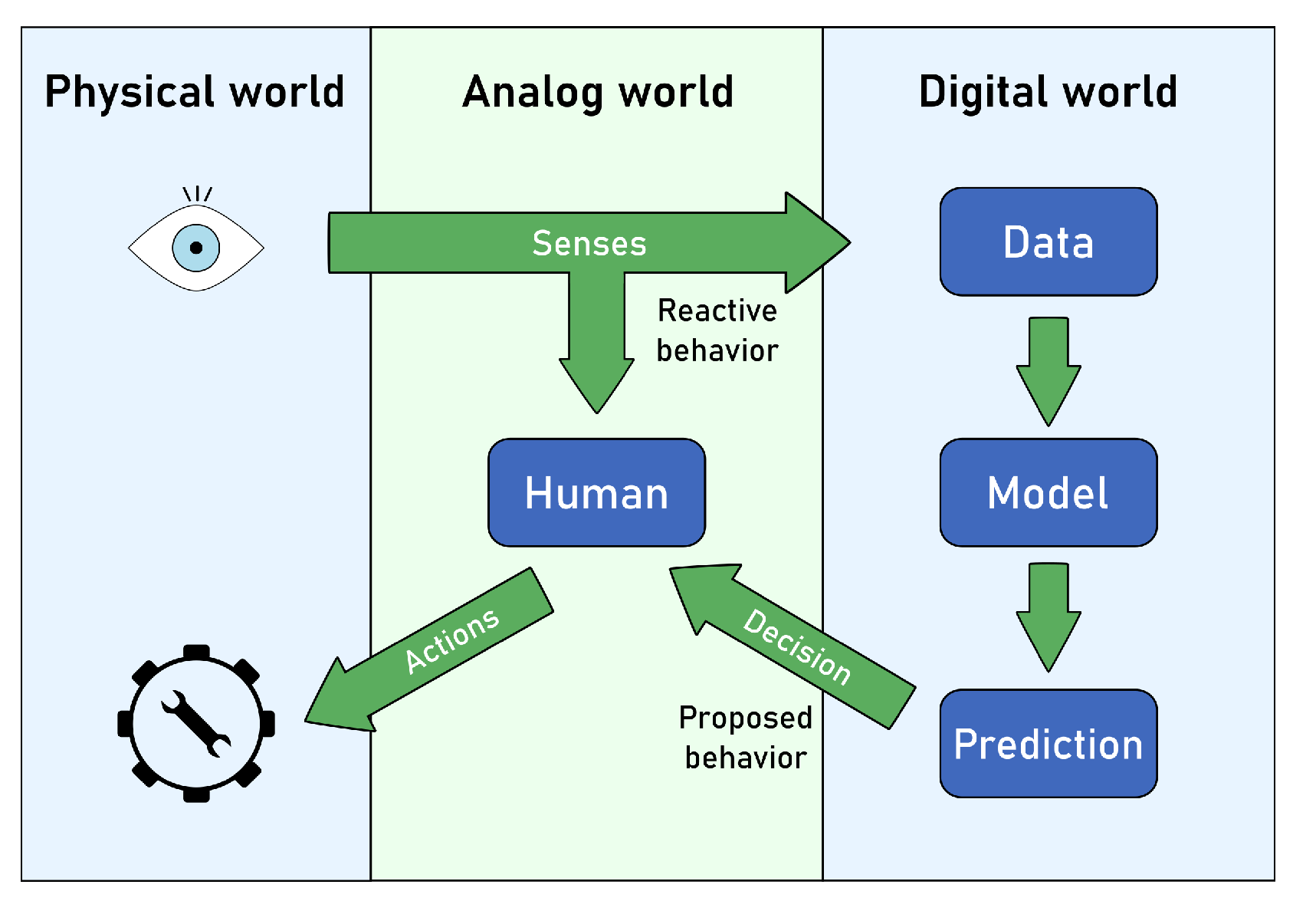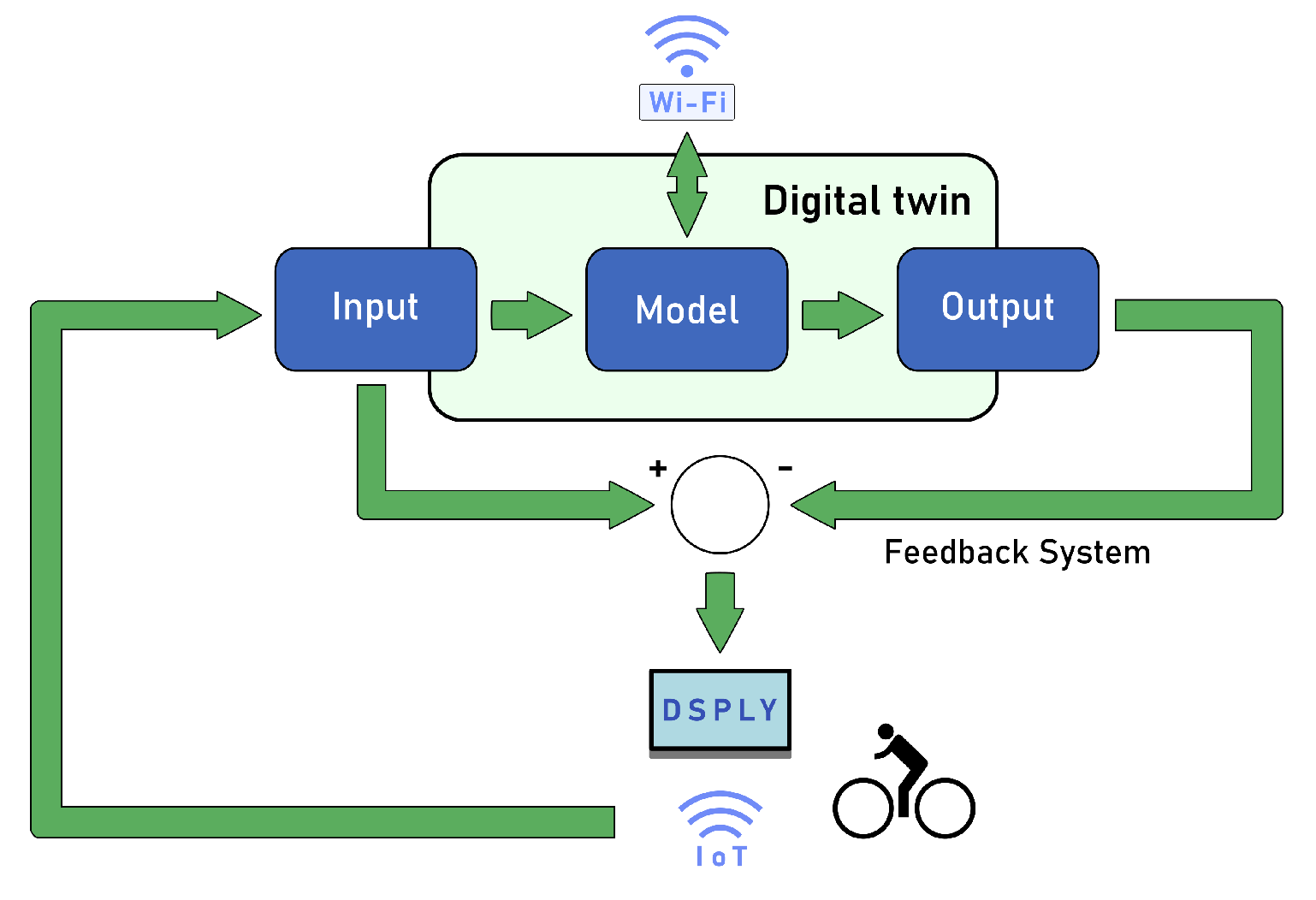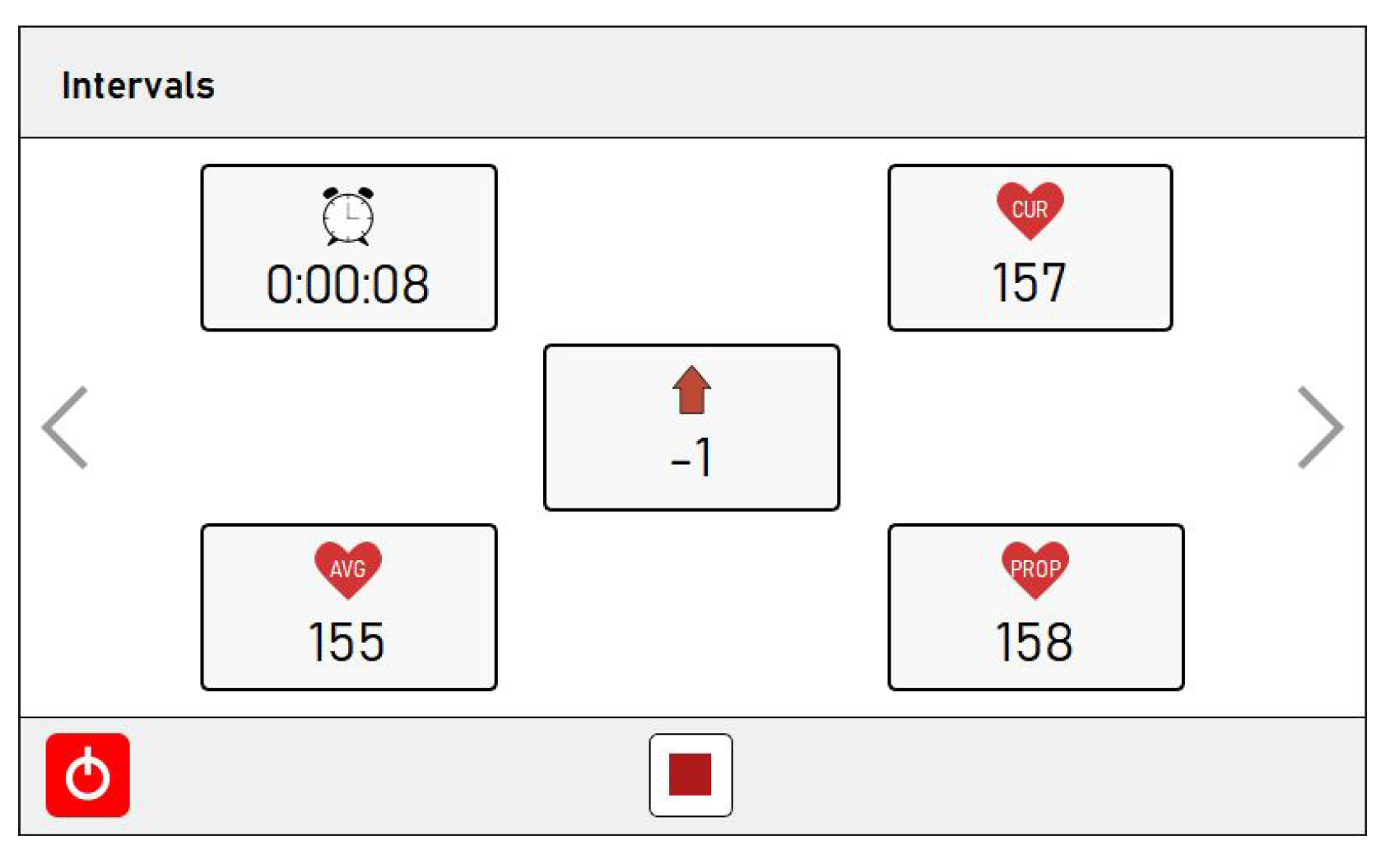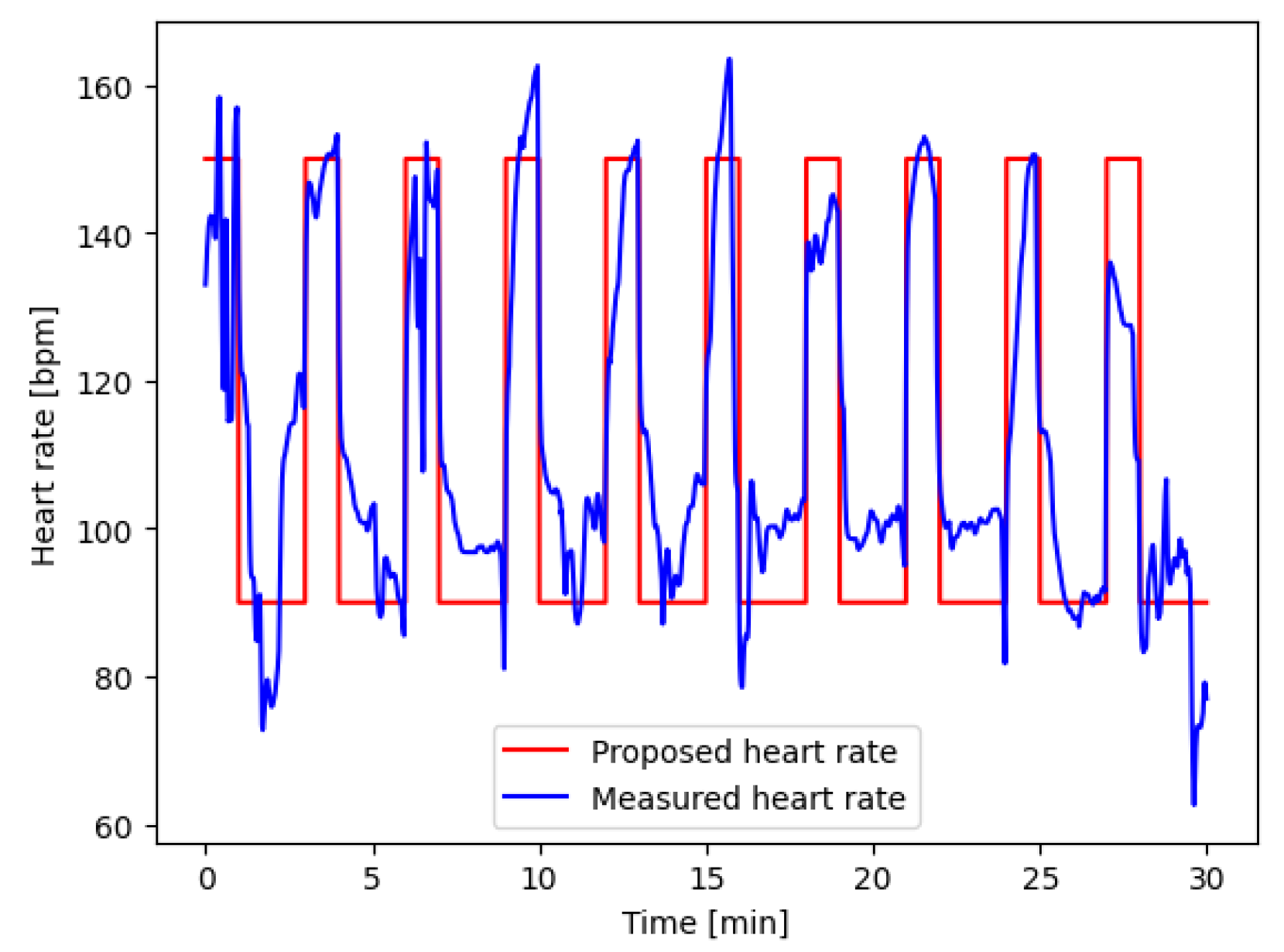The purpose of presenting the results of the experimental work is to show that the proposed digital twin for cycling is user-friendly, robust, reliable, and accurate, and, therefore, has a huge potential to be applied in a real-world environment. In line with this, the results obtained in more tests are summarized as follows:
4.1.1. Analysis of GUI
A GUI in computer science allows seamless interaction between an application and a user. The GUI for a digital twin allows two functionalities: (1) selecting and loading the appropriate interval cycling training session, and (2) controlling the implementation of the loaded session.
The GUI of the proposed digital twin is designed according to the following guidelines [
30]:
minimalist and aesthetic design;
operating system compatibility;
data integrity;
easy navigation and usability;
security.
The minimalist design means that unimportant and not relevant information is kept to a minimum. That is, the display must be reduced for displaying only those elements that are necessary for the implementation of the interval cycling training session. The central point of the digital twin GUI presents an implementation of the interval cycling training session (
Figure 3), where only five icons are presented, denoting five training load indicators. The icon in the center of the screen denotes the difference between the proposed and average heart rate. In the perception process of the cyclist, the image of the icon gets relayed back to his/her brain. Obviously, a motivated athlete wants to minimize the negative value of the difference as fast as possible. These icons are designed in an aesthetic way that attracts the athlete to look at the screen. In the sense of virtual reality, the real situation is additionally emphasized by using sound besides the visual display elements. For instance, when either the end of the current interval or the start of the next one has occurred, the event is announced by a sound signal to the athlete. Although a more detailed heartrate GUI could be displayed in
Figure 3, the minimalist design guideline prevents us to made it more complex.
Operating system compatibility demands that the GUI design should ensure portability on similar platforms. The digital twin GUI is implemented in the Python programming language with the use of the PyQt5 framework. Although it is intended to be used on a Raspberry Pi device, PyQt5 ensures broad portability to various computer platforms.
Data arising in a digital twin do not remain on the origin platform for a long time, because they are copied after finishing each implementation onto the AST central system. Obviously, this is equipped with data integrity mechanisms as well.
Navigation of this GUI is simple due to the limited number of screens. Moreover, this is not even desired for the implementation screen, which is devoted to monitoring performance and prediction data only, where even navigation is excessive.
The security of the mobile device is ensured using an encrypted communication channel and allowing access to the application to the registered users only.
4.1.2. Case Study 1: Results of the Professional Cyclist
In Case Study 1, a professional cyclist was invited to implement a proposed interval training session as presented in Algorithm 4. The interval training session was estimated by a sport trainer as moderate, because it consisted of 10 repeats of the speed/recovery intervals, where the speed interval lasts 1 min at an intensity of 150 bpm (i.e., the tempo HR zone), while the recovery one lasts 2 min at an intensity of 90 bpm (i.e., the active recovery HR zone).
Research Question 1 (RQ-1) in the Case Study 1 was set as: “How to determine that the cyclist implementing the interval training session is a professional by using the DT in cycling?”. The average efficiency of the implementation was measured and recorded by the DT. The experimental period was of duration , where 10 denotes the number of experimental phases and 3 is duration of one speed/recovery interval. Normally, the implementation of the sport training session was conducted 2 h after eating. Here, a time series analysis was performed for the participant and the results of the analysis were visualized. The following criterion was asserted for accepting the proposition: “If the efficiency of the implemented interval training session is higher than 90%, then the cyclist is a professional cyclist”.
The implementation of the interval training session was performed in sunny and calm weather at
, while a straight round track with little traffic was selected for the implementation. Consequently, the cyclist can be focused only on his riding on the track. The results of the implementation of the interval training session are illustrated graphically in
Figure 4, which is divided into 10 speed/recovery intervals, displayed according to the overcoming time (x-axis) by the heart rate (y-axis). Actually, there are two different heart rate curves drawn: the proposed
or
, and the measured
. Thus, the proposed heart rate curve is drawn in red, while the measured one in blue.
As can be seen in the diagram, the cyclist’s measured tries to follow the proposed or as closely as possible. Interestingly, only in speed intervals 1, 4, and 6, the measured overcomes the proposed substantially, while, in the other cases, the is near to or below the proposed . When the recovery intervals are observed, it can be concluded that the prominent valleys overcoming the proposed arose in the recovery intervals 1, 3, 6, and 10. In the other recovery intervals, the measured is near to the proposed . Let us emphasize that the prominent peaks and valleys are a necessary condition for achieving the average for either or .
Although the diagram in
Figure 4 illustrates explicitly how the measured
adapts to the proposed
and
based on the predicted
online, we are interested in how efficient was the implementation of the interval training sessions in the sense of the training load indicator TRIMP. In line with this, the
and
are calculated for each speed and recovery interval, respectively.
The calculated results for the speed intervals are presented in
Table 3, which is divided into more columns denoting the proposed average TRIMP for the speed interval
, the measured TRIMP in the same interval
, the difference between the proposed average and measured speed intervals
, and the corresponding efficiency
.
Let us emphasize that the negative values of the differences show that the professional cyclist did not succeed in satisfying the demands of the interval training session totally. The same fact is also justified when the efficiency of the interval training is observed (i.e., ).
The situation becomes even worse when the recovery intervals are taken into account (
Table 4).
In this case, the value of measured TRIMP in recovery interval outdoes the proposed average as can be seen by observing the positive values of the recovery differences . In total, the efficiency decreases to .
4.1.3. Case Study 2: Results of the Amateur Cyclist
In Case Study 2, an amateur cyclist underwent the same interval training session as the professional due to a more realistic comparison between each other. This means that the male cyclist needs to overcome the interval training session consisting of a 1 min speed interval at 150 bpm followed by a 2 min recovery interval at 90 bpm.
Research Question 2 (RQ-2) in Case Study 2 was set as: “How to determine that the cyclist implementing the interval training session is not a professional by using the DT in cycling?”. The developing propositions, the case study design, and the performed data analysis were the same as in Case Study 1, while the criterion for accepting the proposition was asserted as follows: “If the efficiency of the implemented interval training session is lesser than 90%, then the cyclist is not a professional”.
The graphical results of the amateur cyclist are illustrated in
Figure 5, where the meaning of the displayed variables is the same as by the professional cyclist.
As can be seen from
Figure 5, the amateur cyclist did not achieve the demands of the sport trainer in the recovery interval. Although measured heart rate
strongly surpasses the proposed value of the speed interval
, the proposed value of the recovery interval
is never achieved by the cyclist.
The detailed analytical results of the implemented speed intervals by the amateur cyclist are presented in
Table 5, from which it can be seen that the cyclist achieved even better results according to the TRIMP load indicator in the speed intervals than the professional one. The efficiency of the professional training is even
in total.
Unfortunately, the same cyclist failed to satisfy the demands of the sport trainer when the recovery intervals are observed (
Table 6).
The efficiency of the implementation is now only in total.












